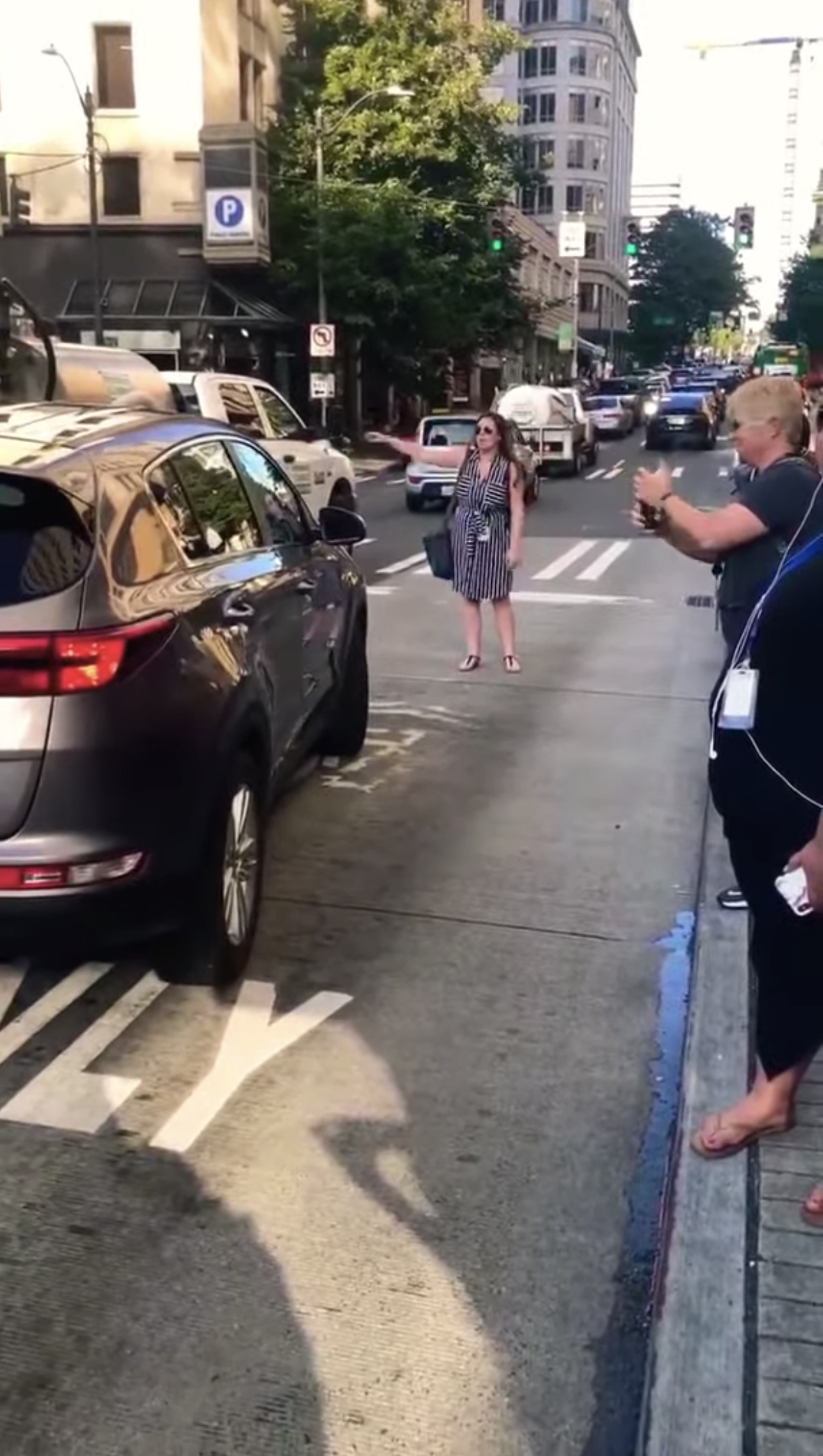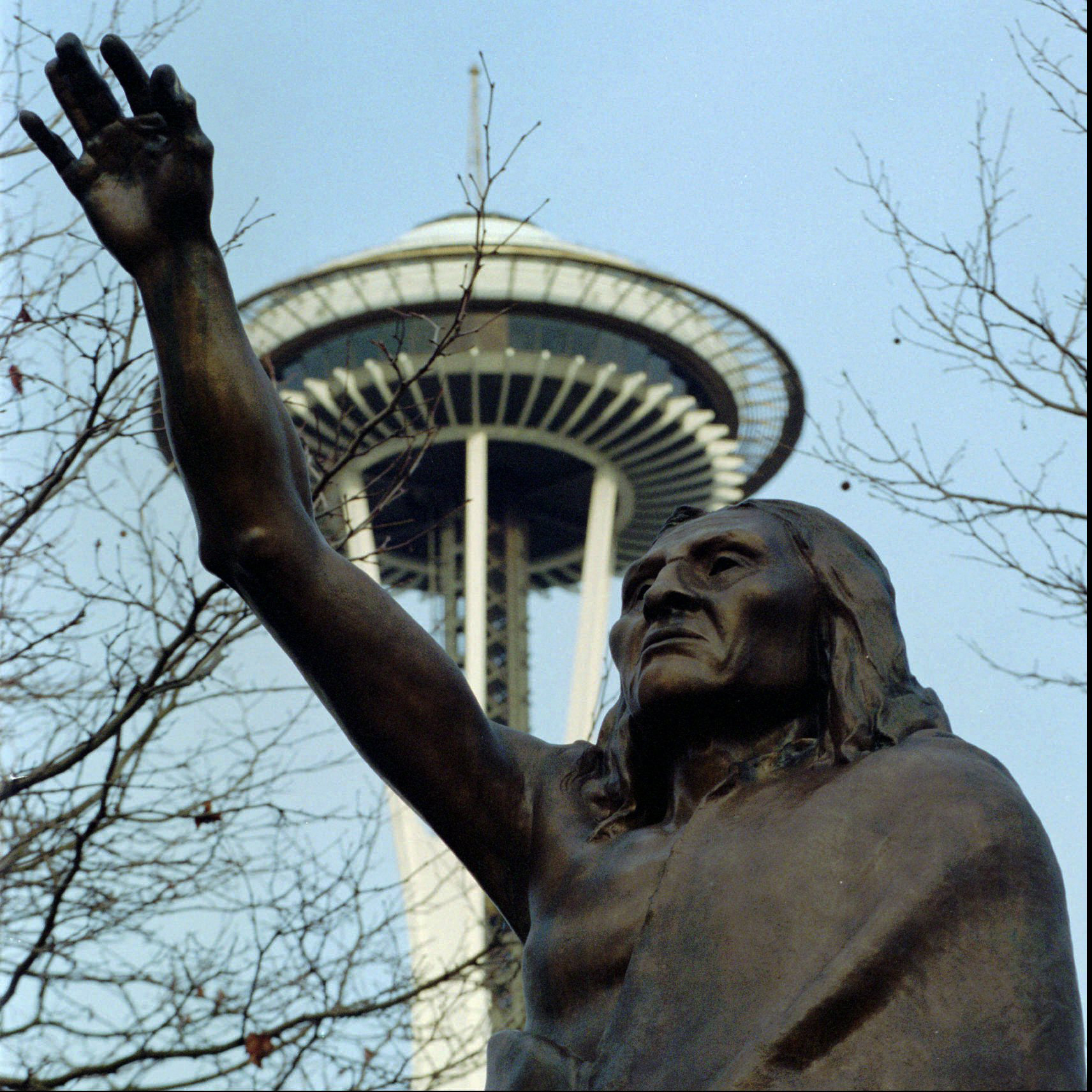One of the newest is Bus Lane Woman. Here is a Seattleite seeking order and justice. She stepped into a bus lane at Sixth and Olive to tell cars that were intruding to keep out of the damn bus-only lane. She was standing for the environment, for the good citizens who take transit, for not tolerating the unwieldy mob of scofflaw car commuters. The video of her taking on car culture went viral. She spoke from the heart for many Seattleites weary of driver misdeeds. She spawned a bevy of imitators. She is not the first Seattleite to turn vigilante over cars. In 1906, when the horseless carriage was first causing havoc on city streets, anonymous protesters built speed bumps to slow down what they called “automaniacs,” who were racing around at, oh, 20 mph. Bus Lane Woman isn’t solving a problem, but she was making a point heard around the town.

A more obvious enduring symbol of Seattle is Chief Seattle. We are the largest major city named for a Native American leader. His profile is on the city seal. He’s also a symbol for how we’ve treated Native peoples and culture. Although naming the city “Seattle” was intended to honor him, he wasn’t asked for his permission. The name itself is a mispronunciation (“Sealth” is close, “Se’ahl” even closer). He was eventually paid for use of his name, but it was appropriation. Chief Seattle’s famous speech at an 1854 treaty conference was translated, transcribed and probably later augmented by a white man for white audiences. As that speech has come down to us, it reminds us of the perpetual presence of the past, and of the resilience and importance of the Salish peoples who lived here first and helped create the city we live in. One of the most powerful lines of his speech rings true: “At night, when the streets of your cities and villages shall be silent and you think them deserted, they will throng with the returning hosts that once filled and still love this beautiful land. The white man will never be alone.” Indeed, we are not, and we best honor the chief and Native peoples with better behavior.
Back during the first decade of the 20th century, a bearded man full of tall tales became a familiar civic symbol: Umbrella Man, named for the unique umbrella hat he wore. The old codger looked like, as HistoryLink.org says, a “cross between an Old Testament prophet and a raggedy Santa Claus.” He told stories about his adventures as an Indian scout and fighting in the Civil War — some were even true. He also predicted the weather. His name was Robert Patten, and he was a familiar sight on Seattle streets. We still debate using umbrellas in Seattle, but Patten solved the problem by turning the bumbershoot into headgear, and he came to symbolize the rainy city. So much so that he was also rendered by artists into a popular newspaper cartoon figure. At a time when local cops could, with no justification, arrest anyone who seemed weird or quirky, Patten mostly generated endearment. He was a street character. His picture was on postcards, his image on souvenir spoons and book covers, and, more recently, he was subject of a graphic novel. In a city that likes quirky, Umbrella Man was once king.

And then there’s Bertha. Yes, the giant boring machine that got stuck digging the new tunnel under downtown, which led to legal wrangling over who was responsible for her breakdown. But with the tunnel complete and operational, and the Alaskan Way Viaduct down, we can begin to see the advantages. Perhaps more importantly, Bertha has revived interest in her namesake, Bertha Knight Landes. She was Seattle’s first female mayor — the first female mayor of any major city — back in the late 1920s. She was a powerhouse of reform and fought city police corruption. We can be proud of being on the progressive cutting edge regarding gender in politics, although it was nearly a century until we elected our second female mayor, Jenny Durkan. Both of our female mayors discovered that the job of mayor in Seattle is no picnic. Like the boring machine, the position requires slow, steady, determined work to get anything done. And you need tough blades to cut through the crap.

Perhaps Seattle’s most iconic figures are its pop stars: Jimi Hendrix, Bruce and Brandon Lee, Kurt Cobain. They were local creatives who live on in people’s hearts. Jimi has a park named for him and a statue on Broadway; the Lees have one of the most visited gravesites in the city, always laden with fresh flowers and treasures; Cobain’s bench in Viretta Park is covered with graffiti and offerings, an enduring shrine to grunge. Seattle has produced other stars, but these three combine the power of rock, television, film and international stardom. All died too young and unexpectedly; all spoke to people of all races and classes, and across political lines. Seattle has a reputation for nurturing artists; we like to take credit for stimulating the creative spirit. Whether we deserve that reputation is debatable, but we’ve embraced these artists as symbols of what we’d like to think we do best. Who can blame us?


